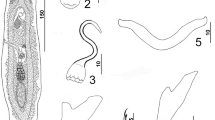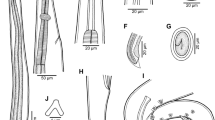Abstract
Purpose
Many nematode species parasitizing marine fishes were reported from Japanese waters. However, considering the wealth of fish species in this zoogeographically interesting region and the host specificity of nematodes, the number of hitherto recorded fish nematodes probably represents only a very small part of the potential Japanese fauna of these organisms. Therefore, new data are needed to recognise the species composition of these parasites in this region.
Methods
Helminthological examinations of some marine fishes from off Japan, carried out in the years 2005–2017, revealed one new and five insufficiently known species of ascaridoid and seuratoid nematodes. These were studied with the use of light and scanning electron microscopy.
Results
All six nematode species recorded are described: Anisakidae: Raphidascaris (Ichthyascaris) multipapillata sp. nov. (male and females) from the intestine of Labracoglossa argenteiventris Peters (Kyphosidae) in the Sea of Japan, Raphidascaris (Ichthyascaris) sp. (third-stage larvae) probably from the digestive tract of Seriola dumerili (Risso) and S. rivoliana Valenciennes (both Carangidae) in the western North Pacific Ocean off Ishigaki-jima Island, Okinawa Prefecture, Hysterothylacium simile Li et al., 2013 (males and females) from the stomach of Lateolabrax japonicus (Cuvier) (Lateolabracidae) in the Sea of Japan, Hysterothylacium sp. 1 (female) from the pyloric caeca of Jaydia lineata (Temminck et Schlegel) (Apogonidae) in the Seto Inland Sea, Hysterothylacium sp. 2 (third- and fourth-stage larvae) from the intestine and mesentery of Etelis coruscans Valenciennes (Lutjanidae) and Pseudorhombus pentophthalmus Günther (Paralichthyidae) in the western North Pacific Ocean off Ishigaki-jima Island, Okinawa Prefecture and the Seto Inland Sea, respectively; and Cucullanidae: Cucullanus sp. (female) from the intestine of Semicossyphus reticulatus (Valenciennes) (Labridae) in the Seto Inland Sea. Raphidascaris (I.) multipapillata sp. n. differs from congeners mainly in the high number (79) of pairs of caudal papillae, spicules 402 µm long and in the structure of the male and female tail tips. Hysterothylacium simile is redescribed, being recorded from off Japan for the first time.
Conclusions
In addition to the discovery of the new nematode species R. (I.) multipapillata sp. nov. and a redescription of H. simile providing some new morphological data of this parasite, the findings of all other species represent new host and geographical records. The present study extends the knowledge of the species composition and host–parasite relationships of nematodes parasitizing marine fishes.











Similar content being viewed by others
References
Moravec F, Nagasawa K (2000) Some anisakid nematodes from marine fishes of Japan and the North Pacific Ocean. J Nat Hist 34:1555–1574
Moravec F, Nagasawa K (2018) Rhabdochona angusticaudata sp. n. (Nematoda: Rhabdochonidae) from the Japanese eels Anguilla japonica, and new records of some other nematodes from inland fishes in Japan. Folia Parasitol 65:016. https://doi.org/10.14411/fp.2018.016
Nagasawa K (2016) A checklist of the parasitic nematodes of freshwater fishes of Japan (1905–2016)—Part 1. Bull Hiroshima Univ Mus 8:61–90 (in Japanese with English abstract)
Nagasawa K (2017) A checklist of the parasitic nematodes of freshwater fishes of Japan (1905–2016)—Part 2. Bull Hiroshima Univ Mus 9:121–142 (in Japanese with English abstract)
Moravec F, Ogawa K (2019) Description of two new species of Philometra Costa, 1845 (Nematoda: Philometridae) from marine fishes off Japan, with notes on Philometroides seriolae (Ishii, 1931). Acta Parasitol 64:829–838. https://doi.org/10.2478/s11686-019-00107-y
Moravec F, Nagasawa K (2020) Some spirurid nematodes (Spirurida) from freshwater and brackish-water fishes in Okinawa Prefecture, Japan, with descriptions of two new species. Acta Parasitol (in press)
Moravec F, Nagasawa K, Nitta M, Tawa A (2019) New records of philometrids (Nematoda: Philometridae) from marine fishes off Japan, including description of Philometra kidakoi sp. n. and Congerinema japonicum gen. et sp. n. Folia Parasitol 66:021. https://doi.org/10.14411/fp.2019.021
Moravec F, Nagasawa K, Hatama T (2020) Some nematodes from eels (Anguilla spp.) in Japan, with descriptions of two new species. Syst Parasitol (in press)
Anderson RC, Chabaud AG, Willmott S (eds) (2009) Keys to the nematode parasites of vertebrates. Archival volume. CAB International, Wallingford
Gibbons LM (2010) Keys to the nematode parasites of vertebrates. Supplementary volume. CABI, Wallingford
Froese R, Pauly D (eds) (2019) FishBase. World Wide Web electronic publication, version 12/2019. http://www.fishbase.org. Accessed 10 Dec 2019
Moravec F, Justine J-L (2020) New records of anisakid nematodes from marine fishes off New Caledonia, with descriptions of five new species of Raphidascaris (Ichthyascaris) (Nematoda, Anisakidae). Parasite 27:20. https://doi.org/10.1051/parasite/2020016
Moravec F, Nagasawa K (2002) Redescription of Raphidascaris gigi Fujita, 1928 (Nematoda: Anisakidae), a parasite of freshwater fishes in Japan. Syst Parasitol 52:193–198
Bruce NL (1990) Hysterothylacium Ward and Magath, 1917, and Ichthyascaris Wu, 1949, ascaridoid nematodes from Australian demersal fishes. Mem Queensl Mus 28:386–426
Moravec F, Justine J-L (2012) Raphidascaris (Ichthyascaris) etelidis n. sp. (Nematoda, Anisakidae), a new ascaridoid nematode from lutjanid fishes off New Caledonia. Zoosystema 34:113–121
Yooyen T, Moravec F, Wongsawad C (2011) Raphidascaris (Ichthyascaris) arii sp. n. (Nematoda: Anisakidae), a new ascaridoid nematode from marine catfishes in the Gulf of Thailand. Helminthologia 48:262–267. https://doi.org/10.2478/s11687-011-0037-z
Li L, Liu Y-Y, Liu B-C, Zhang L-P (2012) Morphological and molecular evidence for a new species of the genus Raphidascaris (Nematoda: Anisakidae) from marine fishes from the South China Sea. Parasitol Res 110:1473–1479. https://doi.org/10.1007/s00436-011-2650-7
Yamaguti S (1935) Studies on the helminth fauna of Japan. Part 9. Nematodes of fishes, 1. Jpn J Zool 6:337–386
Yamaguti S (1941) Studies on the helminth fauna of Japan. Part 33. Nematodes of fishes, II. Jap J Zool 9:343–395 (Plts IV–VI)
Sheenko PS (1992) To the revision of genera Raphidascaris, Raphidascaroides, Ichthyascaris, Alibagascaris (Nematoda, Anisakidae). Biol Nauki 346:45–55 (in Russian)
Moravec F, Gey D, Justine J-L (2016) Nematode parasites of four species of Carangoides (Osteichthyes: Carangidae) in New Caledonian waters, with a description of Philometra dispar n. sp. (Philometridae). Parasite 23:40. https://doi.org/10.1051/parasite/2016049
Deardorff TL, Kliks MM, Rosenfeld ME, Rychlinski RA, Desowitz RS (1982) Larval ascaridoid nematodes from fishes near the Hawaiian Islands, with comments on pathogenicity experiments. Pac Sci 36:187–201
Hasegawa H, Williams EH, Bunkley-Williams L (1991) Nematode parasites from marine fishes of Okinawa, Japan. J Helminthol Soc Wash 58:186–197
Peng W, Liu S, Wang B, Wei M (2011) A checklist of parasitic nematodes from marine fishes of China. Syst Parasitol 79:17–40. https://doi.org/10.1007/s11230-010-9288-1
Shamsi S, Poupa A, Justine J-L (2015) Characterisation of ascaridoid larvae from marine fish off New Caledonia, with description of new Hysterothylacium larval types XIII and XIV. Parasitol Int 64:397–404. https://doi.org/10.1016/j.parint.2015.05.014
Li L, Zhang L-P, Liu Y-Y (2013) Hysterothylacium simile n. sp. and H. aduncum (Rudolphi, 1802) (Nematoda: Raphidascarididae) from marine fishes in the Bothai and Yellow Sea, China, with comments on the record of H. paralichthydis (Yamaguti, 1941) from Chinese waters. Syst Parasitol 84:57–69. https://doi.org/10.1007/s11230-012-9389-0
Fujita T (1932) On new nematodes (Contracaecum) in fishes of Japan. Bull School Fish Hokkaido Imp Univ 2:36–40 (Figs 1–18)
Yamaguti S (1954) Parasitic worms mainly from Celebes Part 9. Nematodes of fishes. Acta Med Okayama 9:122–133
Yamaguti S (1961) Studies on the helminth fauna of Japan. Part 57. Nematodes of fishes, III. J Helminthol, R.T. Leiper suppl, pp 217–228
Moravec F, Nagasawa K (1998) Hysterothylacium japonicum sp. n. (Nematoda, Anisakidae) from the rare marine fish Trachipterus ishikawai in Japan. Acta Parasitol 43:39–42
Moravec F, Nagasawa K (1998) Hysterothylacium nipponense nom. n. for H. japonicum Moravec et Nagasawa, 1998 preoccupied by Hysterothylacium japonicum Rajyalakshmi, 1996. Folia Parasitol 45:328
Lester RJG, Sewell KB (1989) Checklist of parasites from Heron Island, Great Barrier Reef. Austr J Zool 37:101–128
Bruce NL, Adlard RD, Cannon LRG (1994) Synoptic checklist of ascaridoid parasites (Nematoda) from fish hosts. Invertebr Taxon 8:583–674
Li L, Liu Y-Y, Zhang L-P (2012) Morphological and genetic characterization of Hysterothylacium zhoushanensis sp. nov. (Ascaridida: Anisakidae) from the flatfish Pseudorhombus oligodon (Bleeker) (Pleuronectiformes: Paralichthyidae) in the East China Sea. Parasitol Res 111:2393–2401. https://doi.org/10.1007/s00436-012-3095-3
Shamsi S, Eisenbarth A, Saptarshi S, Beveridge I, Gasser RB, Lopata AL (2011) Occurrence and abundance of anisakid nematode larvae in five species of fish from southern Australian waters. Parasitol Res 108:927–934. https://doi.org/10.1007/s00436-010-2134-1
Moravec F (2013) Parasitic nematodes of freshwater fishes of Europe, Revised second edition. Academia, Prague
Moravec F, Justine J-L (2018) Three new species of Cucullanus (Nematoda: Cucullanidae) from marine fishes off New Caledonia, with a key to species of Cucullanus from Anguilliformes. Parasite 25:51. https://doi.org/10.1051/parasite/2018050
Campana-Rouget Y (1957) Parasites de poissons de mer ouest-africains récoltés par J. Cadenat. Nématodes (4e note). Sur quelques espèces de Cucullanidae. Révision de la sous-famille. Bull Inst Fond Afr Noire Sér A 19:417–465 (Plts I–VIII)
Petter A-J (1974) Essai de classification de la famille des Cucullanidae. Bull Mus Nat Hist Nat, 3 sér No. 255. Zool 177:1469–1490
Campos A, Carbonell MD, Rodriguez-Babio C (1993) Cucullanus carbonelli n. sp. (Nematoda, Cucullanidae) parasite du poisson labridé Symphodus tinca. Vie Milieu 43:225–229
Petter A-J, Radujković BM (1989) Parasites des poissons marins du Montenegro: Nematodes. Acta Adriat 30:195–236
Acknowledgements
We thank Masaya Iida (Japan Sea National Fisheries Research Institute) and Yuichiro Ochi (Hiroshima University) for providing nematode samples from L. japonicus and S. reticulatus, respectively. We are grateful to the staff of the Research Center for Subtropical Fisheries (Seikai National Fisheries Research Institute, Fisheries Research Agency) for providing laboratory facilities. We acknowledge Kohei Ito (Hiroshima University) and Hirotaka Katahira (Azabu University) for assistance with fish sampling. Thanks are also due to the Laboratory of Electron Microscopy, Institute of Parasitology, Biology Centre CAS, institution supported by the MEYS CR (LM2015062 Czech-BioImaging) for their support with obtaining scientific data presented in this paper, and to Blanka Škoríková of the same Institute for help with the illustrations.
Funding
This study was partly supported by the institutional support of the Institute of Parasitology, BC AS CR (RVO: 60077344).
Author information
Authors and Affiliations
Corresponding author
Ethics declarations
Conflict of interest
The authors declare that they have no conflict of interest.
Ethical approval
All applicable institutional, national and international guidelines for the care and use of animals were followed.
Additional information
Publisher's Note
Springer Nature remains neutral with regard to jurisdictional claims in published maps and institutional affiliations.
Rights and permissions
About this article
Cite this article
Moravec, F., Nagasawa, K. & Nitta, M. Description of Raphidascaris (Ichthyascaris) multipapillata sp. nov., Redescription of Hysterothylacium simile Li et al., 2013 and New Records of Some Other Ascaridoid and Seuratoid Nematodes from Marine Fishes in Japan. Acta Parasit. 66, 461–474 (2021). https://doi.org/10.1007/s11686-020-00299-8
Received:
Accepted:
Published:
Issue Date:
DOI: https://doi.org/10.1007/s11686-020-00299-8




